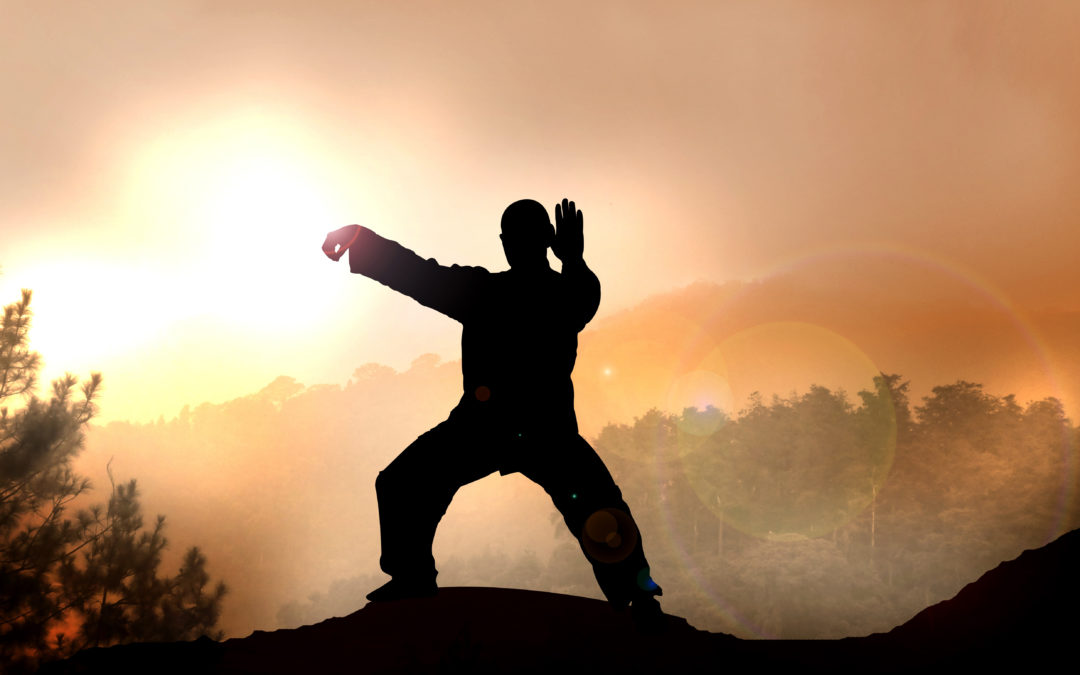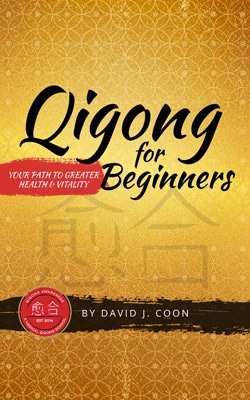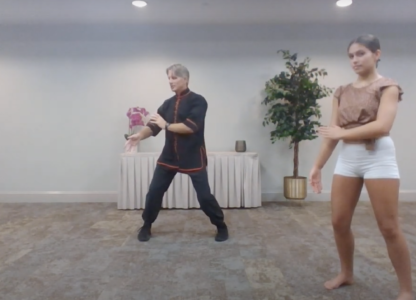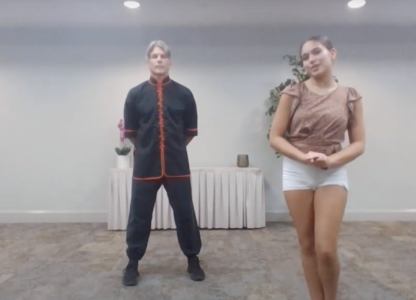What is Qigong?
Qigong (pronounced chee gong, chee gung, or chee kung), is an ancient form of exercise from China. It consists of a combination of mindful movements, still postures, meditation, and breathing techniques. Qigong is a holistic practice that connects mind, body, and spirit.
Qigong has recently become popular all around the world for its many health benefits, but it originated in China over 4,000 years ago. The word “qigong” comes from the Chinese words “qi,” which refers to energy found in all things (a universal life force), and “gong” which means skilled cultivation. Qigong, therefore, means “energy work” or “skilled cultivation of energy.” As a practice, qigong works by gathering and harnessing this energy for increased awareness, well-being, and vitality.
In this intro video to Qigong, Instructor David J. Coon will answer some of the most commonly asked questions and will share with you a beginning Qigong practice that you can learn right now:
What is Medical Qigong?
Qigong generally refers to a gentle exercise practiced individually or with others, but it can also be a form of healing treatment—this is called Medical Qigong. Medical Qigong, like Acupuncture or herbal medicine, is a form of Traditional Chinese Medicine (TCM) and it consists of healing guided by a skilled Medical Qigong Practitioner. Throughout our lives, the energy that flows within each of us can become imbalanced, blocked, or disrupted due to different kinds of bodily strain, including poor diet, injury, aging, or illness. A Medical Qigong practitioner helps a client balance these energy flows to enable the body to return to a state of health and harmony. Medical Qigong is also especially effective at working through deep-seated discomforts or repressed emotions, leading to a relief of stress and regulation of hormones. In this way, Medical Qigong offers a non-invasive form of healing that supports the body’s innate ability to heal itself.
Medical Qigong is a form of primary medicine in many of the hospitals in China. It is the father of Acupuncture. It is oftentimes offered as a solo treatment and in other instances, it is offered in conjunction with Acupuncture Treatment. Not only is Medical Qigong a form of medical treatment, but it also includes prescriptive Qigong Exercises to remedy or support specific health conditions such as high blood pressure, cancer, and back pain to name a few. With certain challenging health conditions, patients will receive both a Medical Qigong Treatment as well as prescriptive Qigong Exercises to practice at home to bring about the healing that is desired. If you are interested in learning more about Medical Qigong, please see this page.
Is Qigong good for you? What are the benefits?
As an exercise that aligns awareness and attention with movement, Qigong has endless mental, emotional, and physical benefits. What makes Qigong unique is that it is different for everyone, and each person may come away with something different depending on where they are in life or what they are seeking. However, a few common benefits shared by many people who practice qigong are a greater sense of peace, calmness, relief from aches and pains, and increased energy and vitality.
More relaxation, less stress
Cultivating qi has tremendous effects in calming the mind. In our day-to-day lives, we face all sorts of scenarios that may cause us stress, whether it be work, illness, or loss—and Qigong helps to set aside a time of day to meditate in a holistic way that engages the body, mind, and spirit. It is amazing what just 10 minutes a day can do! Reducing stress and increasing relaxation also leads to improved sleep, improved neck and shoulder pain, and lower blood pressure. It also helps to alleviate depression and anxiety, and Qigong has been an effective form of support for those contending with cancer or other major life events. Increased relaxation and sleep also result in increased energy, helping fight fatigue and burnout. By harnessing our energy through meditation, Qigong helps us create space for the things that matter and redirect away from those that don’t, improving our moods, attitudes, and outlooks on life.
Physical fitness and exercise
Qigong’s repetition of simple poses and low-impact movements are a great way to strengthen muscles and build new ones you didn’t have before (consistently over a period of time). This results in improved fitness from the inside out, building a strong physical foundation. Qigong’s unique use of stationary poses also helps to cultivate alignment, balance, and flexibility. Those who practice often see great improvement in athletic performance overall and find that it makes a great complement to other activities like biking, walking, or yoga.
For those seeking to lose weight, 1 hour of Qigong provides easily the equivalent of 1 hour of walking and offers many additional benefits that go beyond the linear movement of walking. For more information on Qigong For Weight Loss please see our blog post: What’s Qigong Good For? Can you lose weight?.
Medical Benefits
Just as Qigong reduces stress, Qigong has a number of medical benefits. Moving the body along with steady breathing helps circulate blood flow and massages the internal organs, aiding in cardiovascular health and the maintenance of a healthy metabolism. Qigong is also known to help those who suffer from carpal tunnel, arthritis, or joint pain. Our Qigong Master, David J. Coon, was himself diagnosed with a rare spinal disease at the age of fifteen but has completely healed over many years through steady Qigong practice, oriental medicine, martial arts, and meditation. Medical qigong, mentioned above, also works to heal clients through the aid of a Medical Qigong Practitioner; people seek Medical Qigong for a variety of reasons, including menstrual and fertility health, leg and back pain, insomnia, and more. Qigong is also an excellent form of preventative medicine: keeping stress at bay and boosting the immune system. These practices help reduce risk of serious illness including different forms of cancer. Qigong is the ultimate form of longevity practice. For more on the medical benefits of qigong please see our post What is Qigong.
Connection and Community
Qigong helps open your mind and heart to the world and to make space for yourself as well as those around you. Practicing Qigong brings people together through a connection of this Universal energy called “qi”. Whether you are practicing alone, taking a class online, or alongside others in person, you will be able to feel the connection and support from other like-minded individuals around the world. Those who practice with Qigong Awareness come from a variety of different ages, experiences, and backgrounds, and the graduates of our certification programs teach in a range of different places, from hospitals, businesses, corporations, retreat centers, recreation centers, schools, private healing centers, and more. Healing through Qigong is a shared experience that brings a unique and supportive community of people together. That’s why we at Qigong Awareness think it important to offer a variety of modes of connecting with one another, including in-person workshops, our Facebook Group and YouTube Channel, where we have a vibrant online community.
What’s the difference between Qigong and Tai-chi or yoga?
Qigong, Taichi, and yoga share many common features due to their focus on breath, posture, and movement. Qigong is even sometimes referred to as Chinese Yoga since it has many overlaps with yoga from India. However, yoga often focuses on holding deep, intense stretches, while qigong takes a gentle form of stretching, making it easily accessible for people of all ages, as well as those with varying physical capacities and health conditions.
Many people also ask what makes Qigong different from Tai Chi—and actually, Tai Chi is a form of Qigong! Both are meditative exercises that incorporate movement and breathing techniques and have similar benefits. However, Qigong exercise generally focuses on individual exercises whereas Tai Chi is typically taught as a complete form of choreographed movements that have roots in martial arts. Tai Chi and Qigong are often practiced together. Tai Chi classes will often begin and end with Qigong Exercises and the Tai Chi form will be practiced for the bulk of the class.[For more on the differences between qigong and Taichi, check out our blog post: Which is Better Tai Chi or Qigong.
We could say that Tai Chi is a kind of Qigong like spaghetti is a kind of Italian food. Both are forms of meditative exercise that focus on breathing. Both are excellent for stress reduction and for longevity and are beneficial for overall health, well-being, and weight loss. In fact, Taichi is one of the most popular styles of Qigong around the world. What makes Taichi unique is that it is practiced in specific forms or sets similar to martial arts like Karate, but it is practiced more slowly, with great emphasis on mindfulness. For example, rather than emphasizing linear, hard movements as in Karate, Qigong uses circular, softer movements. Qigong exercise classes also focus on developing the Universal Life Force called Qi more than in a Taichi Class. However, many Tai Chi classes incorporate 10-30 minutes of Qigong.
How do you practice Qigong?
Qigong can be practiced pretty much anywhere you would like: your own living room, outside in a park, on a bench! The important thing is to feel comfortable moving and to be in an environment where you can meditate.
Do you need any special equipment to practice?
You don’t need any special equipment, just you and your breath. Depending on your needs, you may even decide to sit down to practice—Qigong is a highly modifiable, flexible exercise.
How long is a session?
A Qigong Exercise session varies: it can be as few as ten minutes to an hour or more! While it doesn’t have to be practiced every day, we recommend developing a regular habit to really feel the benefits and create a balanced flow of energy.
Who should not do Qigong?
Qigong can be practiced by almost anyone of any age and physical ability, but we recommend adapting the exercise if you have any specific health limitations. The good thing about Qigong is that it is a gentle exercise that can be easily modified depending on your individual needs—nearly all of our exercises can be done from a seated position if standing is not accessible. You can even practice mindfulness through visualization of the movements. Qigong can also be adapted if you are pregnant or recovering from an injury. We recommend you reach out to one of our instructors for detailed guidance. No matter what your situation, you will still gain all of the benefits of Qigong and leave the class feeling relaxed and energized.
Where do I start?
If you are thinking about giving Qigong a go, there are a number of ways to get started. One course we recommend is our 21 Day Qigong Challenge for Beginners. Take ten minutes of your day to breathe, slow down, and feel refreshed! Our challenge is that you do it for 21 days. By practicing for just ten minutes a day, you’ll get to feel how Qigong works in your body while still gaining all of the benefits. We think the best practice comes by setting attainable goals—making Qigong a daily habit will help you build momentum and a strong foundation for future practice. Many studies show that it often takes 21 days to break any habit as well as to start a new one, and our program is designed around that knowledge. However, our program is flexible—you have ongoing access to the program and can choose the time and frequency that works best for you.
If you are more of a reader, Master David J. Coon has also written a book all about Qigong for beginners. Weaving philosophy with his deep knowledge of healing and energy cultivation, the book explores Qigong as an experience of transformation and healing from the inside out and comes with practical exercises for beginners.
If you still want to find out more before you commit to a class, feel free to explore our Youtube channel! You can see what our teaching style is like and view clips from our courses. We also hold free online and in-person events.







